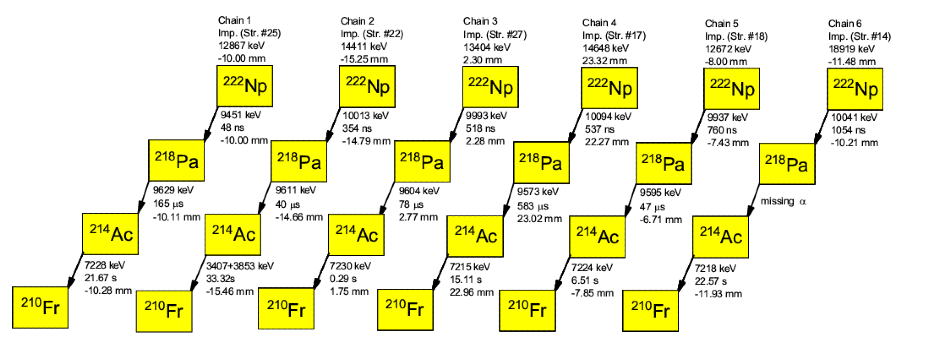Jul 16 2020
The first-ever discovery of 222Np, a new, very short-lived isotope of neptunium (Np), has been reported by scientists from the Institute of Modern Physics (IMP) of the Chinese Academy of Science (CAS) and their collaborators.
 Correlated α-decay chains of 222Np observed in the present work. Image Credit: Institute of Modern Physics.
Correlated α-decay chains of 222Np observed in the present work. Image Credit: Institute of Modern Physics.
As part of the new study performed recently, the researchers even validated the N = 126 shell effect in Np isotopes.
Led by Prof. GAN Zaiguo of IMP, the experiment was performed at the Heavy Ion Research Facility in Lanzhou. The study was published in Physical Review Letters on July 13th, 2020.
Nuclides found in the trans-lead neutron-deficient region tend to decay strongly through the emission of α particles. Therefore, researchers often employ α-decay spectroscopy—an old but robust tool in nuclear physics—to find out new heavy isotopes and to analyze the nuclear structure and the shell evolution of both the ground and excited states in this region.
In earlier studies, researchers experimentally observed a weakening of the impact of the N = 126 shell closure on Z = 92 uranium. Therefore, the question that arises is how the N = 126 shell will evolve above the Z = 92 level.
In the new study, the team produced a very short-lived α-emitting isotope 222Np (where N = 129). This isotope is one of the Np isotopes found just above the N = 126 closed shell. The researchers synthesized the new isotope in the complete-fusion reaction and investigated it using the gas-filled recoil separator SHANS.
It was then identified through the recoil-α correlation measurement technique. The team then determined six α-decay chains and established the decay properties of the 222Np isotope.
The experimental findings of this study are crucial for optimizing the α-decay systematics of Np isotopes around the N = 126 shell. The research team combined the results with the existing data, achieving convincing evidence to demonstrate the stability of the N = 126 magic shell in Np isotopes.
The study, therefore, offers an answer to the question of how stable the N = 126 shell is in Np isotopes.
This study was financially supported by the Strategic Priority Research Program of the CAS, the National Key R&D Program of China, the National Natural Science Foundation of China, etc.
Journal Reference:
Ma, L., et al. (2020) Short-Lived α-Emitting Isotope 222Np and the Stability of the N = 126 Magic Shell. Physical Review Letters. doi.org/10.1103/PhysRevLett.125.032502.